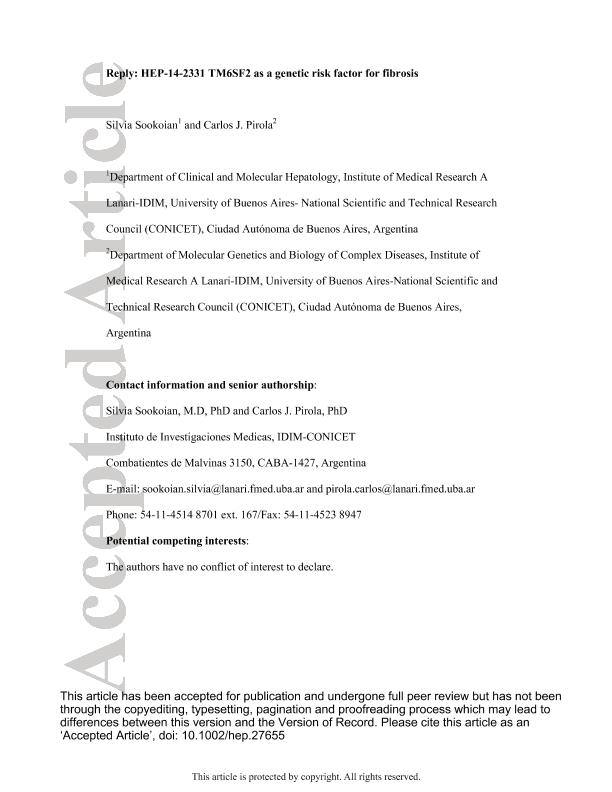Artículo
TM6SF2 as a genetic risk factor for fibrosis.
Fecha de publicación:
04/2015
Editorial:
John Wiley & Sons Inc
Revista:
Hepatology (baltimore, Md.)
ISSN:
0270-9139
Idioma:
Inglés
Tipo de recurso:
Artículo publicado
Clasificación temática:
Resumen
We thank Daly et al. for their interest in our study on the role of TM6SF2 rs58542926 in NAFLD. In our study we confirmed and extended the original findings of Kozlitina et al. who reported a significant association of this variant with liver fat content. We further suggested that rs58542926 regulates liver transcript and protein expression in an allele-specific manner. As Daly et al. noticed, neither we nor others observed an association with liver fibrosis, however, the variant was significantly associated with the degree of histological steatosis and NASH. In fact, a large study from Italy showed that the association with fibrosis was completely abolished after adjusting for NASH (4). Daly et al. misunderstood the concept of ?population stratification? in the 1000 genomes; as shown in Figure 1 there is a clear stratification in the European Ancestry sample that Liu et al. used as control group (5). Population stratification and its effect in spurious allelic associations is largely known , it does affect the frequency of allele variants, but it is not dependent on it . Daly et al. also raised some concerns about the controls we used: subjects whose ultrasonography and laboratory data indicated absence of disease. Conversely, the 1000 genome project used by Liu et al. (5) contains no phenotypic data and the participants cannot be matched for sex or age. In addition, we disagree that we have limited power to detect association with fibrosis. In fact, assuming the additive model of inheritance for an OR of 2.9 (the one reported by Liu et at. and a realistic prevalence of advanced fibrosis of 20%, the power of our sample would be ~99% for a p-value=0.05. In this association sub-study we did not use healthy controls as Daly et al mistakenly stated but NAFLD patients proven by liver biopsy.Furthermore, we agree that rs58542926 is not a rare variant; however, it has been shown that homozygous TT subjects are in fact uncommon around the world.Finally, in our view, the association of the variant with fibrosis is still inconclusive. The assumption of Liu et al. attributing the variant a ?fibrogenic? effect per se (5) is difficult to reconcile with the knowledge gained on hepatic fibrogenesis as a wound-healing response to repeated injury. Further experimental work is required to prove that rs58542926 is involved in fibrosis. Specifically, it would be very interesting to understand how the variant could possibly induce liver fibrosis without affecting the main disease phenotype, NASH/NAFLD as Liu t al. postulated.
Archivos asociados
Licencia
Identificadores
Colecciones
Articulos(IDIM)
Articulos de INST.DE INVEST.MEDICAS
Articulos de INST.DE INVEST.MEDICAS
Citación
Sookoian, Silvia Cristina; Pirola, Carlos José; TM6SF2 as a genetic risk factor for fibrosis.; John Wiley & Sons Inc; Hepatology (baltimore, Md.); 62; 4; 4-2015; 1321-1322
Compartir
Altmétricas




